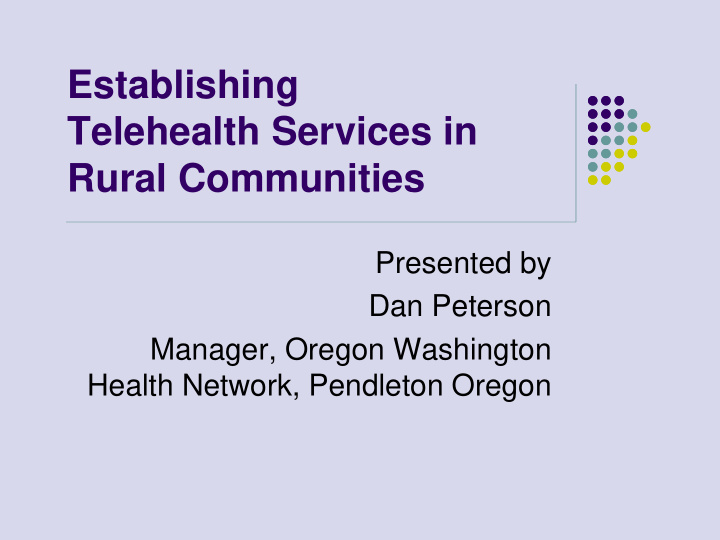



Establishing Telehealth Services in Rural Communities Presented by Dan Peterson Manager, Oregon Washington Health Network, Pendleton Oregon
A. Introduction In 2012, Yellowhawk Tribal Health Center (YTHC) of Pendleton approach 5 agencies about submitting Federal Suicide Grant Upon notice of award a community task force was established with YTHC serving as lead agency. As a result of this collaboration the 5 organizations decided to form a rural heatlh network that became known as OWhN.
A. Telehealth Introduction - Continued In 2014/15 the network expanded to nine (now 10) members and YTHC completed a HRSA planning grant for the network. In 2015, YTHC received a 3-year outreach grant to address gaps in current services. Goals of the grant were: provider recruitment, training, chronic disease, & behavioral health. Telehealth was also determined to be a regional need of the across the network.
A. Telehealth Introduction - Continued In 2016, YTHC on behalf of OWhN received a two year grant from Cambia Foundation to develop a regional telehealth system. The project had three goals: -Establish a regional telehealth system -Train providers and staff to use telehealth equipment including managing referrals -Research/establish required procedures
Map of OWhN Service Area
B. Health Care Needs of Northeast Oregon OWhN’s service area includes 3 Oregon and one Washington County The region generally has high rates of chronic disease. The largest single need is poor access to primary and specialty care All Oregon Counties are health professions shortage area; geographic for dental and MH
Chronic Disease Prevalence of NE Oregon Counties 2010-13 Chronic Condition Umatilla County Union County Morrow County State of Oregon Cancer 6.2% 11.2% 11.5% 8.5% Arthritis 23.9% 28.5% 24.8% 24.5 Angina (Heart 2.2% 7.2% 6.8% 3.6% Disease) Cardio Vascular 8.0% 9.7% 9.6% 7.0% Disease Chronic 5.3% 9.7% 10.4% 5.7% Obstructive Pulmonary Disease Diabetes 7.4% 8.7% 14.8% 8.2% Heart Attack 5.0% 6.4% 8.1% 3.4% Stroke 2.9% No Data 3.8% 2.5% Source: Oregon Health Authority
B. Health Care Needs of Northeast Oregon Pendleton is short 5 primary care providers; half of current providers will retire by 2020 There are numerous shortages in specialty care inc. pediatrics, cardiology & dermatology Currently many patients travel to Walla Walla; Richland & Portland to receive specialty care Other gaps in services include substance abuse treatment, dental, and mental health
C. Planning Process used in Telehealth Development Meetings were held with all partners to define expectations; use of equipment Meetings were arranged & held with telemed providers in Oregon, Washington, & Idaho Price quotes were acquired from 3 vendors Meeting was held with state licensing board to determine licensing & credential process Three network meetings discussed options
D. Training of Medical and Information Technology Staffs Training of providers and staff including IT may be the most important step in development of telehealth system. Three types of training needed. -Initial training of users on telehealth equipment and practices -Skill building of staff prior to start-up -Technical IT staff training incl. software
E. Contracting HUB Services from Telehealth Providers It is most important to contract with your facility’s “natural referral source” If they are not a telehealth providers, establishing a shared system with them should be explored Broad based contracting is recommended HUB provider contract should clearly state costs, services, procedures, and training to be provided
Planned Northeast Oregon Telehealth System Yellowhawk CHI St. Tribal Anthony Health Hospital Center Hub Providence- Kadlec Medical Center Good Pioneer Shepherd Memorial Hospital Hospital
F. Telehealth Equipment Considerations There are numerous equipment providers and many cart options including peripherals There are two major types of equipment: proprietary and standards based Proprietary allow providers to communicate with similar types of equipment Standards based allows facilities to interface with any other standards based system
G. Internal Procedures used for Telehealth Services Patient care protocols based on the services to be procured under contract Patient consent forms including HIPAA A description of the services to be provided to the patient including treatment planning Record Keeping – It is not necessary to have the same electronic health records system Credentialing/privileging done by host agency
H. Telehealth Evaluation and Reporting Data collection important to justify continued use of telehealth services Both clinical (utilization, diagnoses) and non- clinical data (patient surveys, training evaluations) needs to be collected Evaluation should address: clinical outcomes of services; ease of use of equipment; is equipment incorporated into daily routine; cost effectiveness; patient satisfaction
I. Conclusion The bottom line is whether the telehealth system has improved access to care. I’m Glad to take your questions Now!
Recommend
More recommend